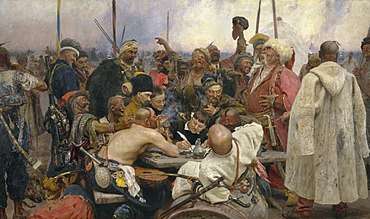Oseledets
Khokhol (Ukrainian: хохол; Russian: хохо́л, IPA: [xɐˈxol]) or oseledets (Ukrainian: оселедець) is the stereotypical Ukrainian cossack style of haircut that features a long lock of hair left on the otherwise completely shaved head, commonly sprouting from the top or the front of an otherwise closely shaven head. It is commonly used as an ethnic slur for Ukrainians.[1]
| Part of a series on |
| Cossacks |
|---|
 |
| Cossack hosts |
| Other groups |
| History |
| Cossacks |
| Cossack terms |

The word comes from Proto-Slavic xoxolъ < *koxolъ, “crest, tuft.”[2]
Colloquialism
Russians commonly use the word khokhol as an ethnic slur for Ukrainians, as it was a common haircut of Ukrainian Cossacks. The term is frequently derogatory or condescending, an equivalent of the Ukrainian term katsap and Polish kacap for Russians.[3]
Historically, Ukrainians used the term khokhol amongst themselves as a form of ethnic self-identification, in order to visibly separate themselves from Russians.[4]
Ukrainian culture
The Ukrainian name for this type of haircut is oseledets (Ukrainian: оселедець, literally "herring") or chub (Ukrainian: чуб, meaning "crest"). There are several Ukrainian surnames derived from this word. In the Cossacks times the haircut carried an honorary meaning identifying one as being a true Cossack. That tradition is depicted in various motion pictures such as Propala Hramota that is based on works of Nikolai Gogol.
The khokhol/oseledets is a standard feature in the stereotypical image of a Ukrainian Cossack.
References
- Laitin, David D. (1998). Identity in Formation: The Russian-speaking Populations in the Near Abroad. Cornell University Press. p. 175. ISBN 9780801484957.
- Mel’nychuk, O. S. (1982–2012). Etymolohichnyĭ slovnyk ukraïnsʼkoï movy [Etymological dictionary of the Ukrainian language]. 6. Kyiv: Naukova Dumka. pp. 205–6. ISBN 978-966-00-0197-8.
- Thompson, Ewa M. (1991). The Search for Self-Definition in Russian Literature. John Benjamins Publishing Company. p. 22. ISBN 978-90-272-7759-6. Retrieved 10 October 2016.
- Plokhy, Serhii (2008). Ukraine and Russia: Representations of the Past. University of Toronto Press. pp. 139–141. ISBN 978-0-8020-9327-1. Retrieved 1 February 2017.
Ethnic identity became the basis for differentiating between 'one's own' from 'foreigners.' Alekseev's use of the terms 'Russians' and 'Ukrainians' - terms of modern national identity - was rooted in concepts characteristic of the revolutionary and postrevolutionary era. His own records, as well as those of other contemporary authors, attest that the names most often used by peasants of the prerevolutionary era with reference to ethnic Ukrainians and Russians were khokhly (referring to Cossack topknots) and katsapy (a derogatory term). These terms, which hardly excluded negative connotations, were used to denote the two ethnic groups faute de mieux: as Rubel's own 'History' attests, Ukrainians used khokhol, inter alia, as a self-definition.